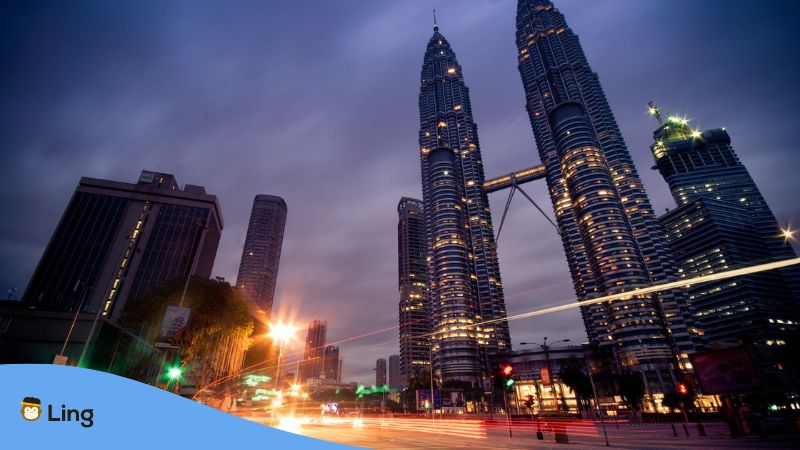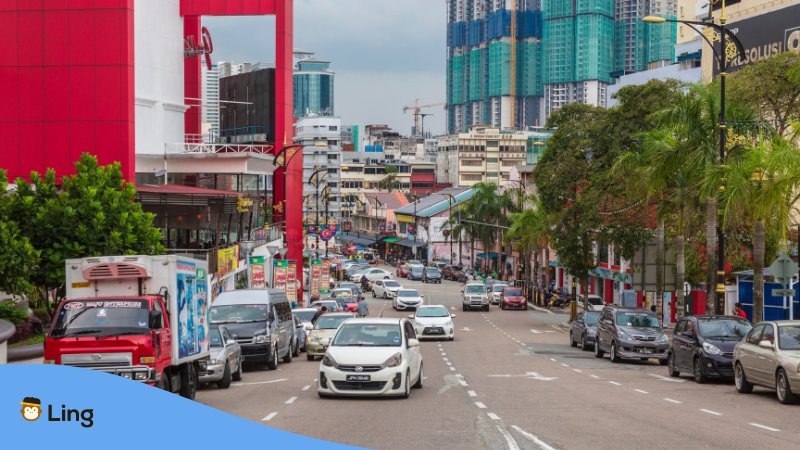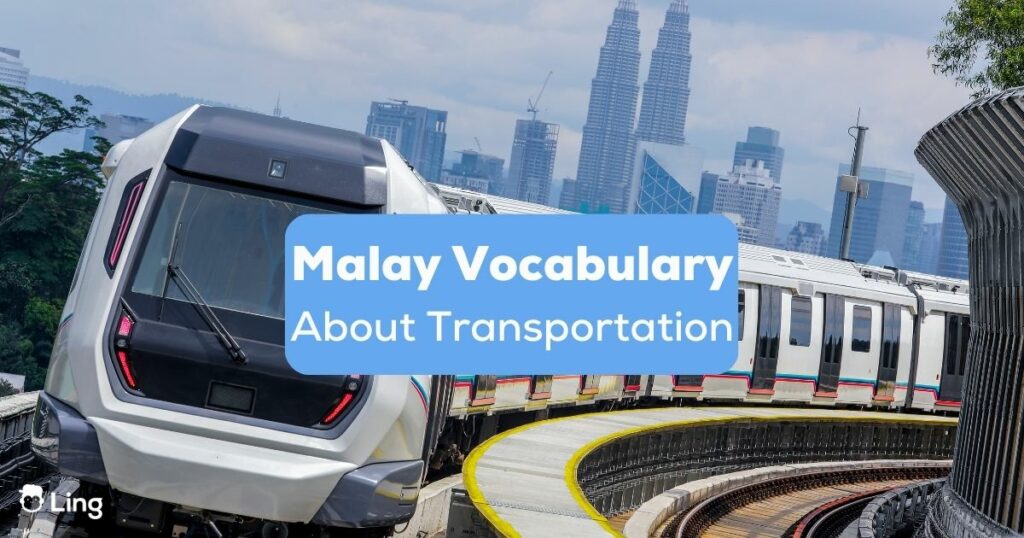Pengangkutan, or transportation in Malay, is a crucial aspect of daily life. It’s like the glue that holds our daily routine together, getting us from point A to B in a jiffy. Think about it, without transportation, we’d have to walk everywhere, and who has time for that in this fast-paced world?
In Malaysia, just like in Singapore and Brunei, transport is a hot topic. With its diverse population and bustling cities, getting around can be challenging, especially if you’re unfamiliar with the local language. But don’t worry because this post will definitely help you!
We’ll talk about the different modes available and the related Malay vocabulary about transportation that may come in handy when getting around. Let’s learn Malay now!
The Transportation System In Malaysia
Malaysia is like a smorgasbord of transportation options, including public buses, trains, taxis, and personal vehicles like cars and motorcycles. Each mode of transportation is like a different dish, each with its unique flavor. You must find the one that suits your taste buds (and budget). Let’s get to know the two major types in the sections below.
By Air
First up, let’s talk about getting around by air. Malaysia has some major airlines and airports that’ll take you places, like Malaysia Airlines, AirAsia, and Malaysia Airports. The country has several international airports, including Kuala Lumpur International Airport (KLIA), Penang International Airport, and Kota Kinabalu International Airport. These airports are connected to major cities worldwide, making it super convenient for travelers.
Pros:
- Fast and convenient, especially for longer distances
- Offers a wide range of destinations
- Comfortable and spacious seating options
Cons:
- Typically more expensive compared to other modes of transportation
- Can be affected by weather and flight-related delays
- Limited baggage allowances

By Train
Next up, trains. The rail network in Malaysia is run by the state-owned operator Keretapi Tanah Melayu Berhad (KTMB), and it connects major cities in the country. You can choose between electric, diesel, and intercity trains and get from Kuala Lumpur to cities like Penang and Johor Bahru in no time.
It’s a must for any traveler to know the local vocabulary for transportation. Especially
Are you looking for the best resource? Look no further than Ling! It’s got all the phrases, familiar words, vocabulary, grammar, and sentence structures you need to master the language, and it’s all wrapped up in a fun, interactive game. Trust us! You’ll speak and understand Malay like a local! Go ahead, give it a try! Download Ling on Google Play or App Store now!
Pros:
- An affordable option for longer distances
- Comfortable seating options
- Connects major cities across the country
Cons:
- It can be slow, especially for longer distances
- A limited number of rail lines and stops
- May be affected by maintenance or service disruptions
By Road
Now that you know a few basic Malay vocabulary about transportation, let’s hit the road. Did you know that Malaysia has everything for road transportation? Well, buses are a popular way to get around and connect cities, towns, and rural areas. Taxis are also readily available in cities and can be hailed on the street or pre-booked.
And, if you’re feeling tech-savvy, you can even use ride-hailing services like Grab. With this, you can choose between private cars and motorbikes and get where you need to go with just a few taps on your phone.
Pros:
- Flexible and convenient for shorter distances and city travel
- An affordable option, especially for taxis and ride-hailing services
- Wide range of vehicle options, including private cars and motorbikes
Cons:
- Traffic congestion can make travel time unpredictable
- May be affected by road closures or accidents
- Parking can be difficult in cities
By Sea
Finally, sea transportation is also a big part of getting around in Malaysia. Ferry services connect the mainland to islands like Langkawi and Penang, making it easy to explore these beautiful destinations. The country also has several ports, including the Port of Tanjung Pelepas and Port Klang, that handle international trade and provide passenger services.
Pros:
- Scenic and enjoyable mode of transportation
- Connects mainland to islands and coastal destinations
- Provides access to remote areas
Cons:
- It can be affected by weather conditions and sea conditions
- It may be slower compared to other modes of transportation
- Limited baggage allowances

The Traffic Situation
Kuala Lumpur, Johor Bahru, and Kota Kinabalu are just some of the cities in Malaysia known for their traffic. Let’s take a closer look below!
The Capital’s Congestion
If you’re planning to visit Kuala Lumpur, Malaysia’s capital city, be prepared for some traffic. The town can get pretty congested during rush hour, especially in the central business district. So, if you’re planning a visit to Petronas Towers or the lively streets of Bukit Bintang, make sure to plan your travels accordingly.
The Gridlock Of Johor Bahru
Johor Bahru, the southern gateway to Malaysia, is another city notorious for its traffic. It’s a popular destination for shopping and dining, but it can also get quite busy on the roads. So, better check the traffic conditions before heading out on the streets to avoid getting stuck in gridlock.
The Smooth Ride In Kota Kinabalu
If you’re looking for a city with smoother traffic, Kota Kinabalu might be your best bet. This coastal city is known for its laidback pace and scenic views, making it a popular destination for tourists and locals alike. With fewer cars on the roads, you can enjoy the scenic drive and easily take in the sights.
Useful Malay Vocabulary About Transportation
Wait, before we continue, here are a few examples of basic Malay words for transportation in Malaysia:
| English | Malaysian | Pronunciation |
|---|---|---|
| Bus | Bas | Bah-s |
| Taxi | Teksi | Tek-see |
| train | Keretapi | Ke-re-tah-pee |
| Ticket | Tiket | Tee-ket |
| Journey | Perjalanan | Per-ja-lah-nahn |
| Destination | Tujuan | Too-joo-an |
| Cost | Harga | Har-gah |
| Time | Waktu | Wahk-too |
| Find | Cari | Char-ee |
| Buy | Beli | Beh-lee |
Essential Malay Phrases For Transportation
You’ll quickly get lost exploring a foreign land, especially when you don’t know the local lingo. But if you try to learn Malaysian, discovering the country’s transportation network is a piece of cake. Here are some conversational Malay phrases to help you with your commute:
| English | Malaysian |
|---|---|
| How much is the ticket? | Berapa harga tiketnya? |
| How long is the journey? | Berapa lama perjalanannya? |
| Where can I catch a bus/taxi/train? | Di mana boleh saya naik bas/teksi/kereta api? |
| How much does it cost? | Berapa bayarannya? |
| I want to get off at (destination) | Saya mahu turun di (destination) |
| Where can I find a taxi/Grab? | Di mana boleh saya cari teksi/Grab? |
| How long will it take to reach (destination)? | Berapa lama kita sampai di (destination)? |
| Where can I buy a ticket? | Di mana boleh saya beli tiket? |
| I want to go to (destination) | Saya mahu pergi ke (destination) |
Transportation Rules For Visitors In Malaysia
Traveling around Malaysia is a must for any tourist. Still, as with any new place, there are specific rules and regulations that visitors should be aware of.
- Driver’s License: Visitors with a valid driver’s license from their home country are permitted to drive in Malaysia for up to 90 days. After that, they will need to obtain an International Driving Permit (IDP).
- Public Transportation: When using public transportation like buses, trains, or taxis, make sure to have small change on hand, as they may not be able to give you change for large bills.
- Trains: Trains in Malaysia have designated women-only cars, and it’s essential to respect this cultural norm by not entering these cars unless you are a woman.
- Taxis: When taking a taxi, it’s better to hire licensed cabs and always agree on the fare with the driver before starting your journey.
- Motorbikes: Renting a motorbike in Malaysia is a popular option. But take note; the traffic can be chaotic. So make sure you’re comfortable riding in such conditions before taking this mode of transportation.
Learn Malay With The Ling App Today
Well, folks, that’s a wrap for our little journey of learning Malay vocabulary about transportation! We’ve covered everything from the different modes of transport in Malaysia to the rules you need to know when traveling and even some useful phrases that’ll come in handy when exploring the country. And now it’s your turn to level up your language skills! Check out the Ling app on your phone now!
Updated by CJ























